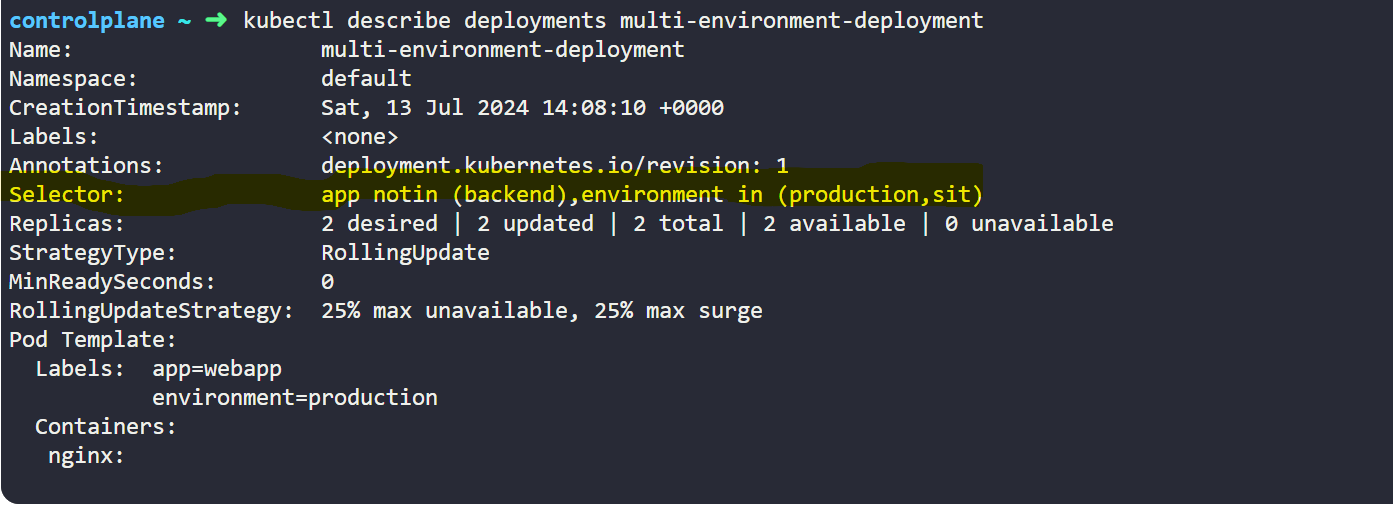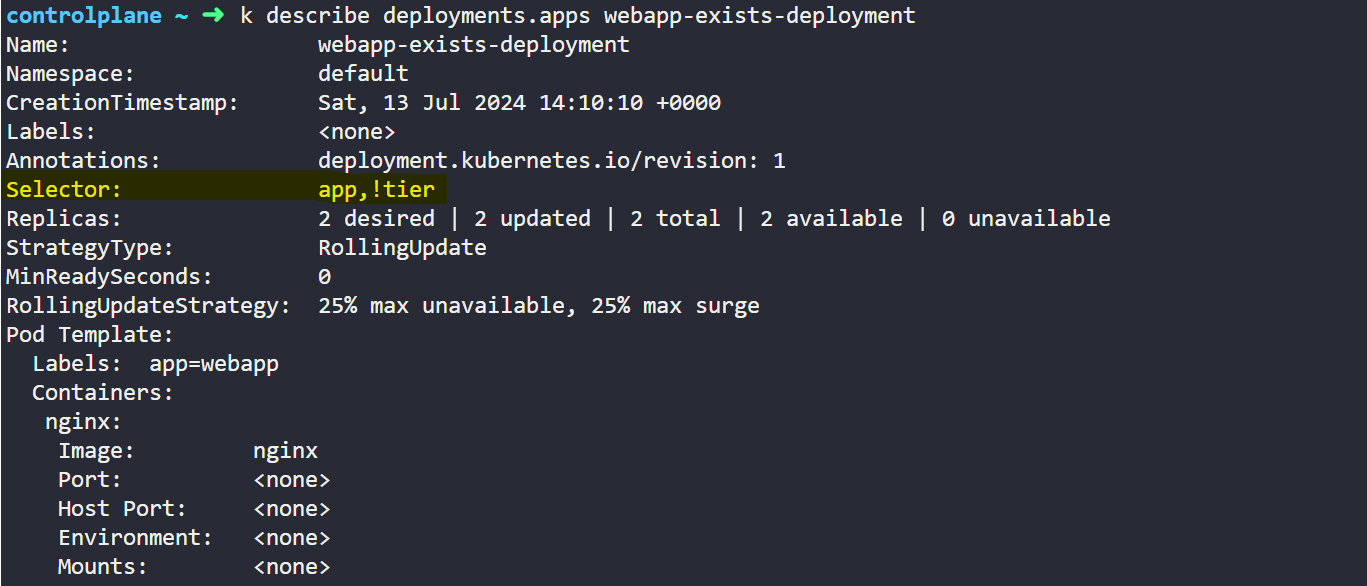Labels and Selector in Kubernetes
 Gaurav Kumar
Gaurav Kumar
Understanding Kubernetes Labels and Selectors
Kubernetes labels and selectors are powerful features that help us to manage and organize our resources within a Kubernetes cluster. Labels are key/value pairs that we attached to Kubernetes objects like pods, services, and deployments. Selectors allow us to query those labels to perform operation on a group of objects. We will understand labels and selectors in this article with example, how it help us to in managing our cluster objects.
Labels
Let's take a example of Pod with labels.
apiVersion: v1
kind: Pod
metadata:
name: webapp
labels:
app: webapp
environment: sit
spec:
containers:
- name: nginx
image: nginx
ports:
- containerPort: 80
Here in above example we can see that the pod is labeled with app: webapp and environment: sit
Selectors
Equality-based selectors: Equality-based selectors allow us to filter objects based on the equality or inequality of their labels.
\= or ==: Equals
!=: Not Equals
Lets understand this Equality-Based Selectors with example. In the below example, Suppose we have 3 different pods and each having different labels.
apiVersion: v1
kind: Pod
metadata:
name: pod1
labels:
app: webapp
environment: sit
spec:
containers:
- name: nginx
image: nginx
---
apiVersion: v1
kind: Pod
metadata:
name: pod2
labels:
app: webapp
environment: sit
spec:
containers:
- name: nginx
image: nginx
---
apiVersion: v1
kind: Pod
metadata:
name: pod3
labels:
app: backend
environment: production
spec:
containers:
- name: nginx
image: nginx
Now, if we want to select only the pods that have labels as app: webapp and environment: sit, we can use Equality-Based Selectors like below.
apiVersion: apps/v1
kind: Deployment
metadata:
name: webapp-sit-deployment
spec:
replicas: 2
selector:
matchLabels:
app: webapp
environment: sit
template:
metadata:
labels:
app: webapp
environment: sit
spec:
containers:
- name: nginx
image: nginx
We can see that in above deployment objects we have used the selector matchLabels: { app: webapp, environment: sit } so that it will select that particular pods.
In below output when we describe the pod by below command.
kubectl describe deployments <deployment-name>
The above command will create below output and where in highlighted section we can see that it has created deployment which has label app: webapp and environment: sit.

- Set-Based Selectors: Set-based selectors allow us to filter objects based on set operations. They use the below operators.
In: Here value must be within a specified set.
NotIn: Here value must not be within a specified set.
Exists: The label key must exist
DoesNotExist: The label key must not exist.
Example usage of In and NotIn operators.
Lets consider the same set of 3 pod which have different labels and here we will use In and NotIn operators in our deployments.
apiVersion: apps/v1
kind: Deployment
metadata:
name: multi-environment-deployment
spec:
replicas: 2
selector:
matchExpressions:
- key: environment
operator: In
values:
- production
- sit
- key: app
operator: NotIn
values:
- backend
template:
metadata:
labels:
app: webapp
environment: production
spec:
containers:
- name: nginx
image: nginx
Here in above Deployment example we have used In operators to select pods with the environment label either as production or sit.
In below output when we describe the deployments by below command.
kubectl describe deployments <deployment-name>
The above command will create below output and where in highlighted section we can see that it has created deployments which has label app: webapp and environment: sit or production.

We have used here NotIn operator also to exclude pods with the app label backend.
Example usage of Exists and DoesNotExist operator.
apiVersion: apps/v1
kind: Deployment
metadata:
name: webapp-exists-deployment
spec:
replicas: 2
selector:
matchExpressions:
- key: app
operator: Exists
- key: tier
operator: DoesNotExist
template:
metadata:
labels:
app: webapp
spec:
containers:
- name: nginx
image: nginx
Here in above example we have used Exists operator to selects pods with the app label, regardless of its value.
The DoesNotExist operator ensures that the deployment does not select the pods with the tier label.
In below output when we describe the deployments by below command.
kubectl describe deployments <deployment-name>
The above command will create below output and where in highlighted section we can see that it has created deployments which has label app regardless of its value and DoesNotExist operator ensures that deployment does not select pods with the tier label.

Practical Example: Blue-Green Deployment
Lets understand the practical usage of Labels and Selectors by Blue-Green Deployment example. In below example we will create 2 Deployment one named blue and other named green.
- Blue Version Deployment
apiVersion: apps/v1
kind: Deployment
metadata:
name: webapp-blue
spec:
replicas: 3
selector:
matchLabels:
app: webapp
version: blue
template:
metadata:
labels:
app: webapp
version: blue
spec:
containers:
- name: nginx
image: nginx
ports:
- containerPort: 80
- Green Version Deployment
apiVersion: apps/v1
kind: Deployment
metadata:
name: webapp-green
spec:
replicas: 3
selector:
matchLabels:
app: webapp
version: green
template:
metadata:
labels:
app: webapp
version: green
spec:
containers:
- name: nginx
image: nginx
ports:
- containerPort: 80
Now Lets create a service to expose the application.
apiVersion: v1
kind: Service
metadata:
name: webapp-service
spec:
selector:
app: webapp
version: blue # Initially point to the blue version
ports:
- protocol: TCP
port: 80
targetPort: 80
type: NodePort
Here in above example we have now exposed Blue version of application to the end users and meanwhile we are developing Green Version of our deployments with some extra features. When the Green Version will be tested internally and we are good to release the Green Version then we just need to update selectors in our service objects like below.
apiVersion: v1
kind: Service
metadata:
name: webapp-service
spec:
selector:
app: webapp
version: green # Finally switched to new version green
ports:
- protocol: TCP
port: 80
targetPort: 80
type: NodePort
That's all we have to understand in labels and selectors in Kubernetes.
Subscribe to my newsletter
Read articles from Gaurav Kumar directly inside your inbox. Subscribe to the newsletter, and don't miss out.
Written by

Gaurav Kumar
Gaurav Kumar
I am working as a full time DevOps Engineer at Tata Consultancy Services from past 2.7 yrs, I have very good experience of containerization tools Docker, Kubernetes, OpenShift. I have good experience of using Ansible, Terraform and others.